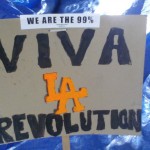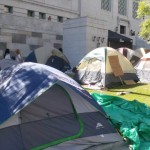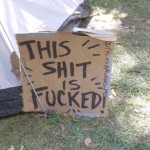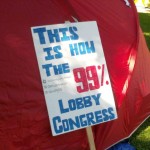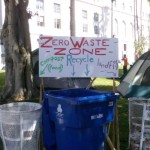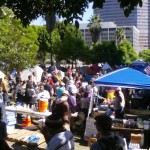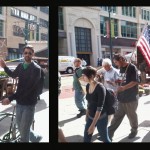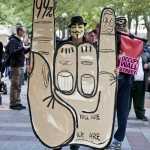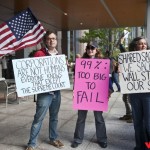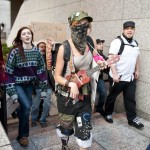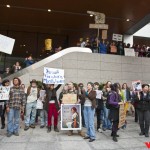OCCUPY LOS ANGELES
October 8th, 2011 – City Hall
In February of 2003 I attended my first protest, located in downtown San Francisco in opposition to the imminent invasion of Iraq by US and allied forces. I remember the feeling of approaching the mass of tens of thousands of people standing on Market Street. The sound was intense, like something you’d hear at a sporting event — if the crowd was literally on fire. It was then that I realized how powerful people can be when united for a cause.
Related Posts
Recently, Adbusters — a Canadian activist foundation that uses culture jamming and advertising spoofs to push an anti-consumerist agenda — came up with an idea to set up camp in New York’s financial district on September 17th. The small gathering of anti-capitalism and anti-corporatism protesters has turned into a monster of a political and social movement, prompting other Occupy Wall Street encampments to take shape not only in the US, but around the world.
With so many in the mainstream media making this out to be a joke, and right wing outlets so quick to dismiss the Occupy movement as a bunch of hippies who have no idea what they are protesting, I needed to get out there and see where these protesters are coming from.
On October 8th, I headed to downtown Los Angeles. Arriving at the encampment around noon, I found dozens upon dozens of tents sprawled across the many lawns of city hall. The area appeared relativity clean and organized, especially considering many had already called this area home for more than a week. Police presence was at a minimum, as I only spotted three officers in uniform during the span of the afternoon. With a music festival scheduled to start at noon, no one was at the microphone on the south end of the block. As I stood there taking in all the various signs, booths, and groups talking amongst themselves, I was caught off-guard by a single voice powered by a bullhorn at the edge of the block.
“It’s much bigger than Wall Street. It’s much bigger than just police brutality. It is a formation of a New World Order,” exclaims the man. These are the words of activist Shane Devins.
Originally from Las Vegas, Devins believes the corruption on Wall Street and in Washington, DC goes far beyond what we are led to believe. He believes organizations like the United Nations, the Bilderberg Group, the Council on Foreign Relations, and the Trilateral Commission are involved with an attempt to create a one world government. Using the private Federal Reserve as a vehicle to destroy the value of the US dollar by way of deflation, the destruction of the US economy will then give way to a new world currency regulated and controlled by the World Bank.
“It has taken almost a hundred years to cripple the US dollar,” says Devins. As I interview him, we search for water around the encampment. “And what Obama talked about at the G20 Summit 2009 is that the World Bank should be and will be the institution that will create a world currency, and that will be regulated under the World Bank and the World Bank will come under the authority of the United Nations.”
While some might balk at the notion of a conspiracy to usher in a one world currency, the actions of the Federal Reserve have brought on much scrutiny from many Occupy Wall Street protesters, leaving little room for straw-man arguments and calls of “kooky conspiracy theorists.”
Signs proclaiming “END THE FED” were a constant sighting at the LA Occupation. One must remember that the Federal Reserve is a private entity that doesn’t answer to Congress; their actions are kept in secret and their actions of manipulating monitory policy has proven to hurt the US economy more than help it. A number of protesters were also calling for the reinstatement of the Glass-Steagall Act, which prevented investment banks and commercial banks from merging. The act was repealed under the Clinton administration with the help of former Obama economic adviser Larry Summers. Many view the repeal as a precursor to the 2008 financial crisis.
Some of those in attendance aired out calls to end capitalism as a whole, though they were in the minority, despite attempts by the mainstream media to convince the public otherwise. Most in attendance were calling for an end of crony capitalism (i.e., “corporatism”). Corporatism is the merger of corporate and governmental powers — Benito Mussolini once stated that corporatism should essentially be called fascism, as many protesters would agree, charging that corporations own our leaders in Washington, DC by way of lobbyist money and the assignment of corporate big-wigs to high governmental positions. Another interesting contingency at the Occupy protest are supporters of the anti-war movement. While most may think of banks when it comes to Wall Street, we must remember that elements of the military industrial complex are a part of Wall Street.
While walking among the tent city, the people, and the countless signs airing out grievances, I found myself returning to those feelings I had back in 2003 in San Francisco. The feeling of community ingrained with those who have shared food, water, and space in a foreign home for over a week, and the camaraderie of people coming together in a peaceful way to air out their concerns and anger — could this be the start of a revolution? This worldwide phenomenon has given me hope that the masses are starting to wake up to the reality that business in Washington, DC continues as usual. Even under a democrat — especially a democrat who received more contributions from Wall Street than any other presidential candidate in US history. “Democrat” and “Republican” don’t matter at the end of the day. Both are guilty of supporting corporate interests over those they are supposed to represent.
Standing on the corner with tambourine and sign in hand, Angus Godwin expresses a sentiment I think is fitting for the majority of protesters who have found solidarity in the Occupy Wall Street movement: “We’re all here because we’re getting screwed, and because bankers are criminals.”
The question now begs to be asked: we have occupied — now what? The ball is in our court. -Matt Edmund
OCCUPY WALL STREET
Ongoing – Zuccotti Park, New York
Zuccotti Park is 33,000 square feet, less than one acre of land. Located in Manhattan’s financial district, it is adjacent to Ground Zero, and 1,000 feet from the New York Stock Exchange. In the last five weeks, Zuccotti Park has been the staging point for the Occupy Wall Street movement. The marches, the signs, the rallying cries, the tweets, the “mic checks,” and the camera positions all begin and end here. For all the outlets referring to the Occupiers as directionless, Zuccotti Park is, for all intents and purposes, where the protestors come to organize.
Upon first impressions, scene at Zuccotti Park is something out of a ’90s movie about the 1960s — one can’t help but expect to hear strains of the Jimi Hendrix version of “All Along the Watchtower” as they walk about the park.
Currently, the ratio of actual protesters to curious onlookers occupying the park is about 80/20. The Occupy movement has been going on so long in one particular area that it is attracting curious tourists. Outlining the borders of the park are the most drastic protests and demonstrations (including the drum circle at the South-Western steps) that are for the onlookers — and especially the TV cameras. What the passersby and the cable TV cameras don’t see is the look beyond what is literally the fringes of the Occupy movement.
Venturing further inward to the center of Zuccotti Park, the shanty-town opens up. By the sheer volume of tents, tarps, and sleeping bags in such a small space, these people are here for the long haul. “Occupy Wall Street” isn’t just a catchy name or a Twitter hash-tag — there is a literal occupation of territory happening in Zuccotti Park. But for all of Zuccotti Park’s new residents, no one is here because they have to be. This isn’t a modern day Hooverville, where people are living because they can’t afford their own homes — it is at the heart of why there is an occupation; the American Dream is no longer attainable for some people, and those who have a vested interest in making sure that Dream remains unattainable are not getting an comeuppance.
The center of Zuccotti Park is where the ideas are exchanged. This is the heart of the operation where one will find pamphlets, instructions for the next march to the New York Stock Exchange, meal options, and reasonable discussion.
The most intriguing phenomenon occurring in the hub is what is referred to as the “Mic Check.” As explained by a student from New Hampshire identified as Cara, the “Mic Check” is when any individual stands up on an elevated plain and declares “Mic Check.” Upon hearing this, many in the crowd repeat it back to inform the others. The person granted this new found status begins speaking in short sentences, which is then repeated by the crowd. The crowds response is to make sure the idea carries through to the rest of the park so even those that are not close enough to hear can understand what is being said. And as there are no leaders, anyone can declare “Mic Check.”
This method of spreading information comes off as part game of “telephone,” and part responsorial psalm. It is an analogue version of how information spreads via social media as a person delivers content, while others around them amplify the idea to others with verbal retweets and likes. The “Mic Check” is an astounding piece of order for a group that is dismissed by some as being “disorganized.”
The role of social media cannot be understated for the Occupy Wall Street movement. For this movement to grow at Ground Zero, ubiquitous access to the internet is imperative, which is why a charging station for laptops and phones is always occupied.
Images of the charging station has been easy fodder for contrarians as evidence that the Occupy Wall Street’s anti-corporate is not really all that anti-corporate, as if using smartphones and laptops dismisses any argument the protesters might have.
To boil down Occupy Wall Street as solely anti-corporate is to miss the point completely. Unfortunately, there is more “anti” sentiment than anything else. While many signs are proclaiming what they are against, there is very little declaring what anyone is for, which obfuscates the entire reason for being in Zuccotti Park. It’s not anti-corporatism driving people here. These are the people that did what they were supposed to do to be successful in the US, only to be denied because a select few holding the purse strings are changing the rules for the sake of quarterly profits. -Nate Griffin
OCCUPY INDIANAPOLIS
October 8th, 2011
The protest in Indianapolis took place at the Veterans Memorial Park in downtown. A small crowd of people congregated around a stage that was set up where speakers shared their thoughts on the state of the nation. The police presence was minimal; off to the side four or five cops congregated underneath the shade of a tree and observed. To the best of my knowledge, no one was arrested. The crowd was rather reserved and non-vocal, and primarily focused their attention on whomever was speaking onstage. –Kristen Arnold
OCCUPY BUFFALO
Ongoing
There have been no arrests or major incidents in Buffalo, New York. The protests have all been peaceful.
Buffalo does have a good-sized financial center with Chase, HSBC, Key Bank, M&T Bank, and First Niagara all having a banking presence downtown. There is a small encampment occupying a part of Niagara Square (which includes the McKinley Monument), and is right in the heart of where the major government buildings are, including City Hall. The camp is largely tents and tarps with a portable toilet recently added. They seem to be well-stocked with food and water — besides, this time of year in Buffalo you don’t really need electricity to keep things cold. The area is a wind tunnel since Niagara Square is only about a mile from Lake Erie. Recently gusts of wind were measured above 40 miles per hour, and yet somehow the tarps stayed up and functioning.
About 40 people recently protested at Chase Bank, with some in costume and most holding signs or flags. There was a police presence with mounted police nearby, but the protest was done peacefully and the police simply stood by. There is a crew of around 12 to 20 people who are have been in Niagara Square daily with signs and flags for three weeks.
The biggest days for the protest are Saturdays. If the sound of the car horns of supportive motorists is any indication, Occupy Buffalo have been receiving good moral support from the community. –Garrett Lyons
OCCUPY SEATTLE
October 8th, 2011
My impression is that the Occupy Seattle protest was largely disunited — too many individual causes being pushed (ie., Native American rights, unions, bank debit fees, job loss, etc.). Also, there was a lack of a solid person in charge. There was a march scheduled for noon that, for an unknown reason, got pushed to 5 PM, and the march seemed to zig-zag before finally ending at the Bank of America building — which was empty on a Saturday evening. It would’ve been more effective on a workday. –Suzi Pratt









